Construction and Evaluation of the Integrated Perception Ecological Environment Indicator (IPEEI) Based on the DPSIR Framework for Smart Sustainable Cities
Abstract
1. Introduction
2. Methodology
2.1. Three-Level Association Mechanism of the Domain-Theme-Element
2.2. IPEEI Model Construction based on the DPSIR Framework
2.2.1. DPSIR Framework
2.2.2. IPEEI Model
2.3. Quantitative Evaluation of the Entropy Weight Method
3. Case Study
3.1. Study Area
3.2. Data Collecting and Processing
3.3. Results
3.3.1. IPEEI Weight Assignment of the WMA
3.3.2. Dimension and Theme Evaluation of IPEEI
3.3.3. Comprehensive Evaluation Grades of the WMA
4. Discussion
4.1. Feasibility and Reliability of the IPEEI
4.2. Systematic Analysis of the IPEEI Model
4.3. Spatio-Temporal Variation of the IPEEI Evaluation
5. Conclusions
Author Contributions
Funding
Acknowledgments
Conflicts of Interest
References
- Tian, H.; Lindenmayer, D.B.; Wong, G.T.W.; Mao, Z.; Huang, Y.; Xue, X. A methodological framework for coastal development assessment: A case study of Fujian Province, China. Sci. Total Environ. 2018, 615, 572–580. [Google Scholar] [CrossRef] [PubMed]
- Zuo, X.; Hua, H.; Dong, Z.; Hao, C. Environmental Performance Index at the Provincial Level for China 2006–2011. Ecol. Indic. 2017, 75, 48–56. [Google Scholar] [CrossRef]
- Chen, Y.; Zhou, H.; Zhang, H.; Du, G.; Zhou, J. Urban flood risk warning under rapid urbanization. Environ. Res. 2015, 139, 3–10. [Google Scholar] [CrossRef] [PubMed]
- Ibrahim, M.; El-Zaart, A.; Adams, C. Smart sustainable cities roadmap: Readiness for transformation towards urban sustainability. Sustain. Cities Soc. 2018, 37, 530–540. [Google Scholar] [CrossRef]
- International Telecommunication Union Focus Group on Smart Sustainable Cities (ITU-T FG-SSC). Technical Report on Smart Sustainable Cities: An Analysis of Definitions; ITU-T FG-SSC; United Nations: New York, NY, USA, 2014. [Google Scholar]
- International Telecommunication Union Focus Group on Smart Sustainable Cities (ITU-T FG-SSC). Shaping Smarter and More Sustainable Cities: Striving for Sustainable Development Goals; ITU-T FG-SSC; United Nations: New York, NY, USA, 2016. [Google Scholar]
- Azevedo Guedes, A.; Carvalho Alvarenga, J.; dos Santos Sgarbi Goulart, M.; Rodriguez y Rodriguez, M.; Pereira Soares, C. Smart Cities: The Main Drivers for Increasing the Intelligence of Cities. Sustainability 2018, 10, 3121. [Google Scholar] [CrossRef]
- Yigitcanlar, T.; Hewa Heliyagoda Kankanamge, R.N.E.; Butler, L.; Vella, K.; Desouza, K. Smart Cities Down Under: Performance of Australian Local Government Areas; Queensland University of Technology: Brisbane, QLD, Australia, 2020. [Google Scholar]
- Yigitcanlar, T.; Kamruzzaman, M.; Buys, L.; Perveen, S. Smart Cities of the Sunshine State: Status of Queensland’s Local Government Areas—2018 Summary Report; Queensland University of Technology: Brisbane, QLD, Australia, 2018. [Google Scholar]
- Lombardi, P.; Giordano, S.; Farouh, H.; Yousef, W. Modelling the smart city performance. Innov. Eur. J. Soc. Sci. Res. 2012, 25, 137–149. [Google Scholar] [CrossRef]
- Bhattacharya, T.R.; Bhattacharya, A.; McLellan, B.; Tezuka, T. Sustainable smart city development framework for developing countries. Urban Res. Pract. 2018, 13, 180–212. [Google Scholar] [CrossRef]
- Carli, R.; Dotoli, M.; Pellegrino, R. Multi-criteria decision-making for sustainable metropolitan cities assessment. J. Environ. Manag. 2018, 226, 46–61. [Google Scholar] [CrossRef]
- International Organization for Standardization (ISO). Sustainable Development of Communities—Indicators for City Services and Quality of Life; ISO 37120:2014; ISO: Geneva, Switzerland, 2014. [Google Scholar]
- International Organization for Standardization (ISO). Sustainable Cities and Communities—Indicators for City Services and Quality of Life; ISO 37120:2018; ISO: Geneva, Switzerland, 2018. [Google Scholar]
- International Telecommunication Union Focus Group on Smart Sustainable Cities (ITU-T FG-SSC). Key Performance Indicators Related to the Use of Information and Communication Technology in Smart Sustainable Cities; ITU-T Y.4901/L.1601; ITU-T FG-SSC; United Nations: Geneva, Switzerland, 2016. [Google Scholar]
- International Telecommunication Union Focus Group on Smart Sustainable Cities (ITU-T FG-SSC). Key Performance Indicators Related to the Sustainability Impacts of Information and Communication Technology in Smart Sustainable Cities; ITU-T Y.4902/L.1602; ITU-T FG-SSC; United Nations: Geneva, Switzerland, 2016. [Google Scholar]
- International Telecommunication Union Focus Group on Smart Sustainable Cities (ITU-T FG-SSC). Key Performance Indicators for Smart Sustainable Cities to Assess the Achievement of Sustainable Development Goals; ITU-T Y.4903/L.1603; ITU-T FG-SSC; United Nations: Geneva, Switzerland, 2016. [Google Scholar]
- Standardization Administration of the P.R.C. Evaluation Indicators for New-Type Smart Cities; GB/T 33356-2016; China National Information Technology Standardization Network: Beijing, China, 2016. (In Chinese) [Google Scholar]
- The State Council of the P.R.C. China’s National Plan on Implementation of the 2030 Agenda for Sustainable Development; United Nations: New York, NY, USA, 2016.
- Chen, J.; Peng, S.; Zhao, X.; Ge, Y.; Li, Z. Measuring regional progress towards SDGs by combining geospatial and statistical information. Acta Geod. Cartogr. Sin. 2019, 48. (In Chinese) [Google Scholar] [CrossRef]
- Big Earth Data Program Chinese Academy of Sciences. Big Earth Data in Support of the SustainabIe DeveIopment GoaIs; Chinese Academy of Sciences: Beijing, China, 2019. [Google Scholar]
- Chen, J.; Liu, W.; Wu, H.; Li, Z.; Zhao, Y.; Zhang, L. Basic Issues and Research Agenda of Geospatial Knowledge Service. Geomat. Inf. Sci. Wuhan Univ. 2019, 44. (In Chinese) [Google Scholar] [CrossRef]
- Chen, J. Framing the Spatio-Temporal Changes in Global Cultivated Land Using GlobeLand30. Sci. Agric. Sin. 2018, 51. (In Chinese) [Google Scholar] [CrossRef]
- Gao, P.; Wang, X.; Wang, H.; Cheng, C. Viewpoint: A correction to the entropy weight coefficient method by Shen et al. for accessing urban sustainability (Cities 42 (2015) 186–194). Cities 2020, 103, 102742. [Google Scholar] [CrossRef]
- Shen, L.; Zhou, J.; Skitmore, M.; Xia, B. Application of a hybrid Entropy–McKinsey Matrix method in evaluating sustainable urbanization: A China case study. Cities 2015, 42, 186–194. [Google Scholar] [CrossRef]
- Sun, C.; Wu, Y.; Zou, W.; Zhao, L.; Liu, W. A Rural Water Poverty Analysis in China Using the DPSIR-PLS Model. Water Resour. Manag. 2018, 32, 1933–1951. [Google Scholar] [CrossRef]
- Leng, S.; Zhai, Y.; Jiang, S.; Lei, Y.; Wang, J. Water-environmental risk assessment of the Beijing-Tianjin-Hebei collaborative development region in China. Hum. Ecol. Risk Assess. Int. J. 2016, 23, 141–171. [Google Scholar] [CrossRef]
- Zhou, G.; Singh, J.; Wu, J.; Sinha, R.; Laurenti, R.; Frostell, B. Evaluating low-carbon city initiatives from the DPSIR framework perspective. Habitat Int. 2015, 50, 289–299. [Google Scholar] [CrossRef]
- Gari, S.R.; Newton, A.; Icely, J.D. A review of the application and evolution of the DPSIR framework with an emphasis on coastal social-ecological systems. Ocean Coast. Manag. 2015, 103, 63–77. [Google Scholar] [CrossRef]
- Sekovski, I.; Newton, A.; Dennison, W.C. Megacities in the coastal zone: Using a driver-pressure-state-impact-response framework to address complex environmental problems. Estuar. Coast. Shelf Sci. 2012, 96, 48–59. [Google Scholar] [CrossRef]
- Organization of Economic Cooperation and Development; Group on the State of the Environment. OECD Core Set of Indicators for Environmental Performance Reviews, Environmental Monograph No.83; OECD: Paris, France, 1993.
- Apostolaki, S.; Koundouri, P.; Pittis, N. Using a systemic approach to address the requirement for Integrated Water Resource Management within the Water Framework Directive. Sci. Total Environ. 2019, 679, 70–79. [Google Scholar] [CrossRef]
- Zare, F.; Elsawah, S.; Bagheri, A.; Nabavi, E.; Jakeman, A.J. Improved integrated water resource modelling by combining DPSIR and system dynamics conceptual modelling techniques. J. Environ. Manag. 2019, 246, 27–41. [Google Scholar] [CrossRef]
- Lange, B.; Holman, I.; Bloomfield, J.P. A framework for a joint hydro-meteorological-social analysis of drought. Sci. Total Environ. 2017, 578, 297–306. [Google Scholar] [CrossRef] [PubMed]
- Jia, X.; O’Connor, D.; Hou, D.; Jin, Y.; Li, G.; Zheng, C.; Ok, Y.S.; Tsang, D.C.W.; Luo, J. Groundwater depletion and contamination: Spatial distribution of groundwater resources sustainability in China. Sci. Total Env. 2019, 672, 551–562. [Google Scholar] [CrossRef] [PubMed]
- Wu, H.; Yu, Y.; Li, S.; Huang, K. An Empirical Study of the Assessment of Green Development in Beijing, China: Considering Resource Depletion, Environmental Damage and Ecological Benefits Simultaneously. Sustainability 2018, 10, 719. [Google Scholar] [CrossRef]
- Wang, W.; Sun, Y.; Wu, J. Environmental Warning System Based on the DPSIR Model: A Practical and Concise Method for Environmental Assessment. Sustainability 2018, 10, 1728. [Google Scholar] [CrossRef]
- Jia, Y.; Shen, J.; Wang, H.; Dong, G.; Sun, F. Evaluation of the Spatiotemporal Variation of Sustainable Utilization of Water Resources: Case Study from Henan Province (China). Water 2018, 10, 554. [Google Scholar] [CrossRef]
- Qiao, W.; Sun, X.; Jiang, P.; Wang, L. Analysis of the Environmental Sustainability of a Megacity through a Cobenefits Indicator System—The Case of Shanghai. Sustainability 2020, 12, 5549. [Google Scholar] [CrossRef]
- Shannon, C.E. A mathematical theory of communication. Bell Syst. Tech. J. 1948, 27, 379–423. [Google Scholar] [CrossRef]
- Gao, P.; Li, Z.; Zhang, H. Thermodynamics-Based Evaluation of Various Improved Shannon Entropies for Configurational Information of Gray-Level Images. Entropy 2018, 20, 19. [Google Scholar] [CrossRef]
- Yang, X.; Ma, C.; Zhang, A. Decomposition of Net CO2 Emission in the Wuhan Metropolitan Area of Central China. Sustainability 2016, 8, 784. [Google Scholar] [CrossRef]
- De Smith, M.J.; Goodchild, M.F.; Longley, P.A. Geospatial Analysis—A Comprehensive Guide, 6th ed.; The Winchelsea Press: London, UK, 2018. [Google Scholar]
- Natural Breaks (Jenks). Available online: http://webhelp.esri.com/arcgisdesktop/9.2/index.cfm?TopicName=Natural_breaks_(Jenks) (accessed on 28 July 2020).
- Ministry of Ecology and Environment of the P.R.C. Technical Criterion for Ecosystem Status Evaluation; HJ 192-2015; Ministry of Ecology and Environment of the P.R.C.: Beijing, China, 2015. (In Chinese)
- Hubei Provincial Development and Reform Commission. Outline of the Overall Plan for the Wuhan Metropolitan Area. Available online: http://fgw.hubei.gov.cn/fbjd/xxgkml/ghjh/201703/t20170327_1543776.shtml (accessed on 28 July 2020). (In Chinese)
- Hubei Provincial Development and Reform Commission. Regional Development Plan of the Wuhan Metropolitan Area (2013–2020). Available online: http://fgw.hubei.gov.cn/fbjd/xxgkml/ghjh/201703/t20170327_1543802.shtml (accessed on 28 July 2020). (In Chinese)
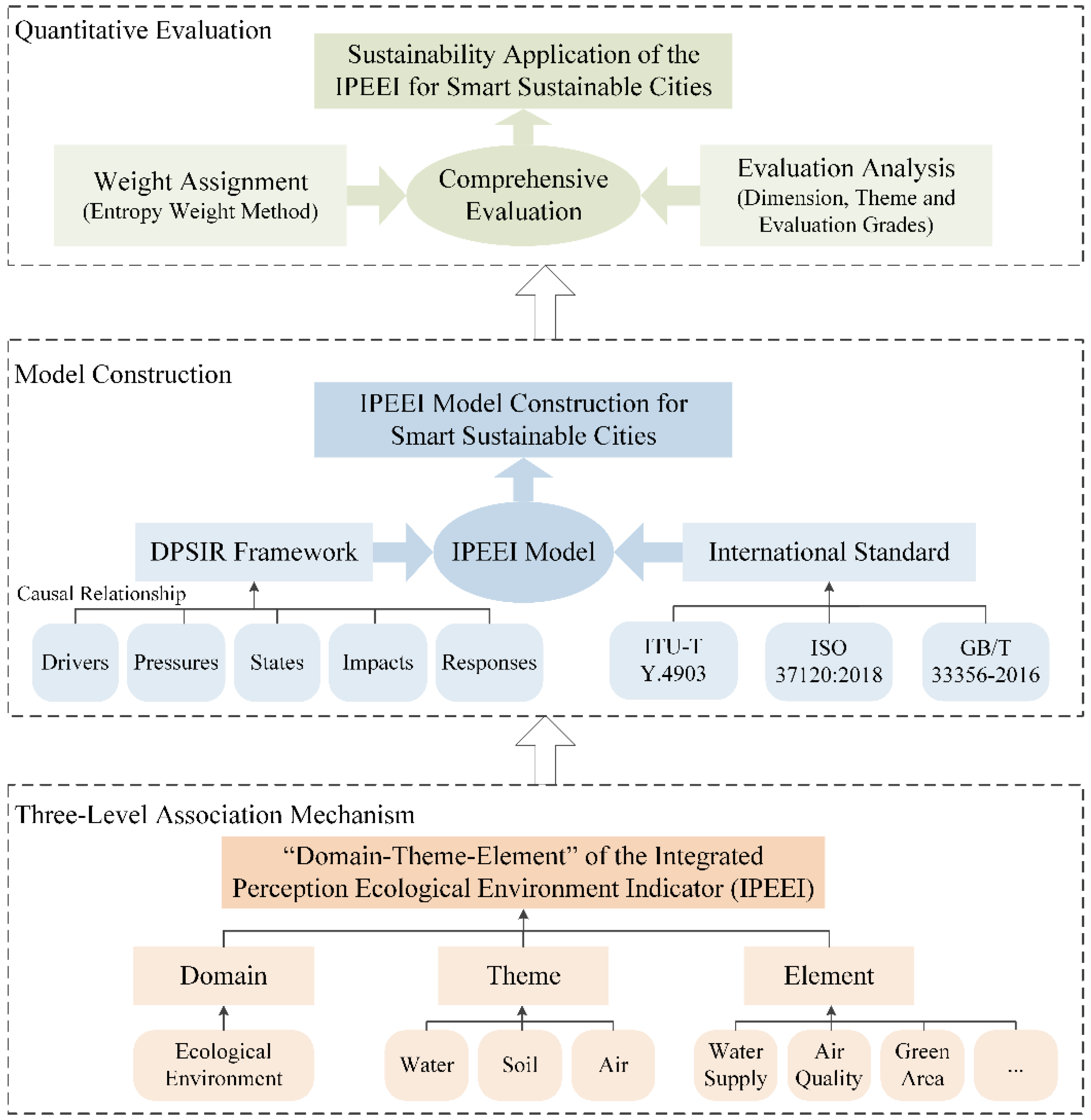
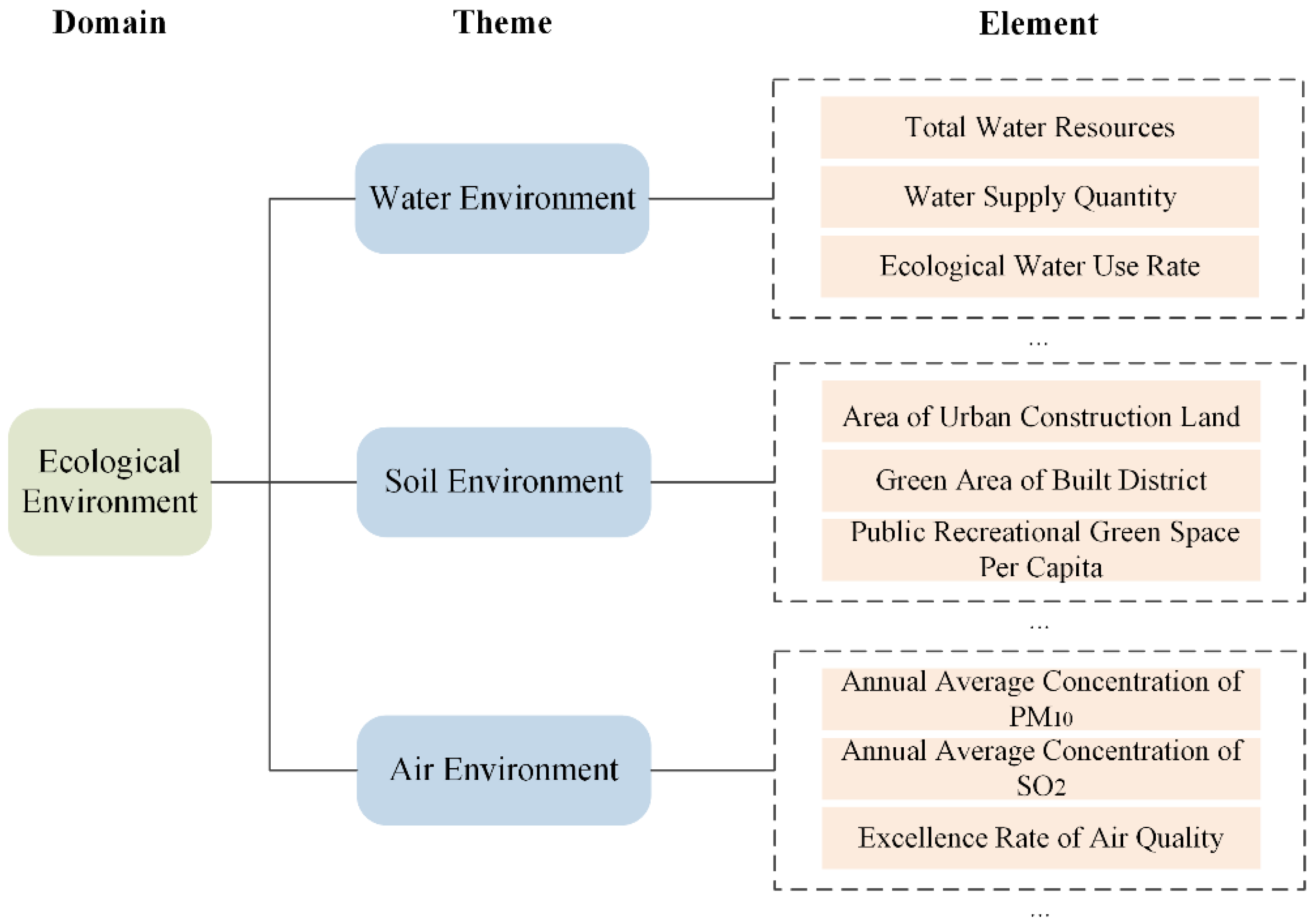
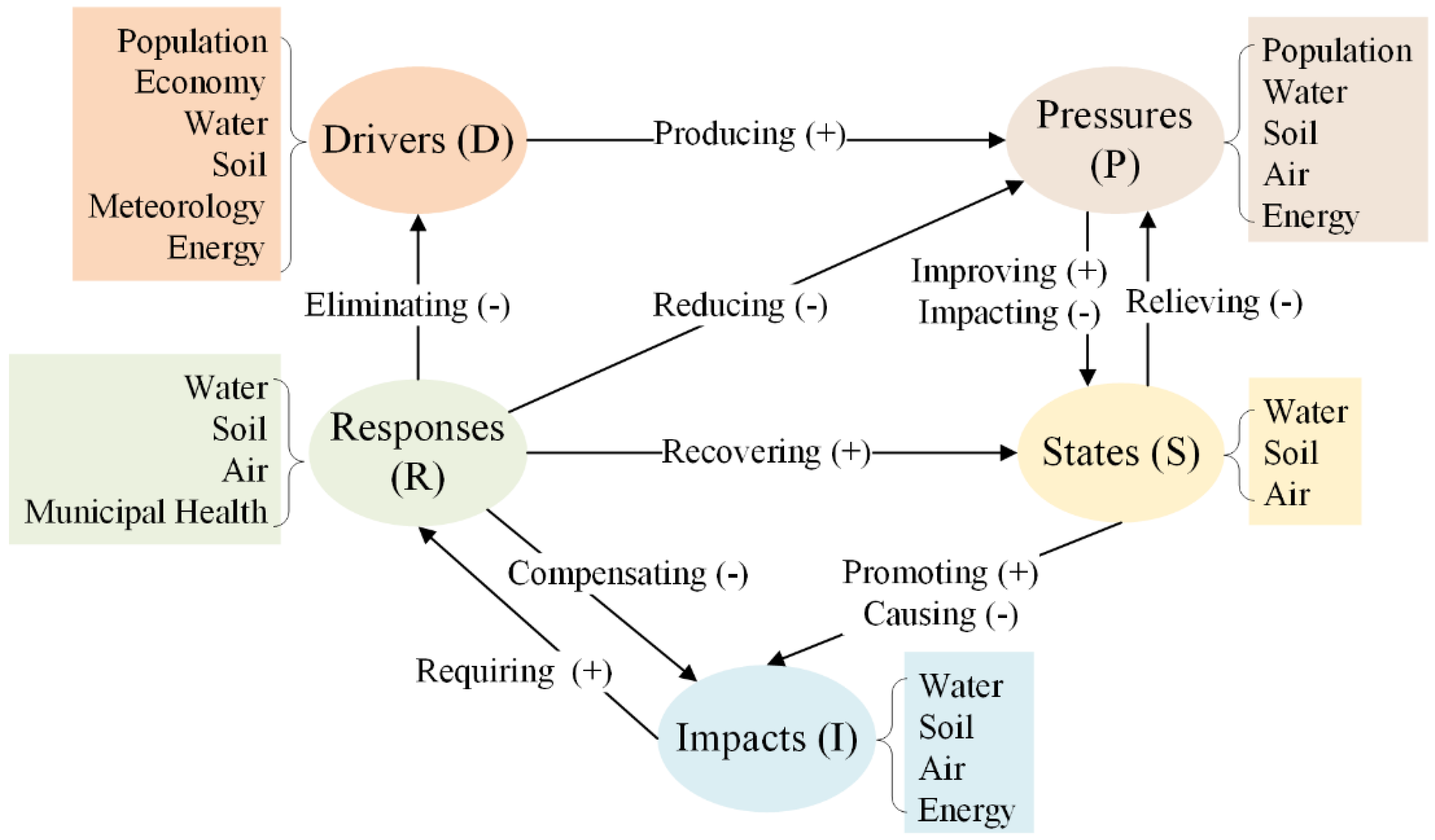

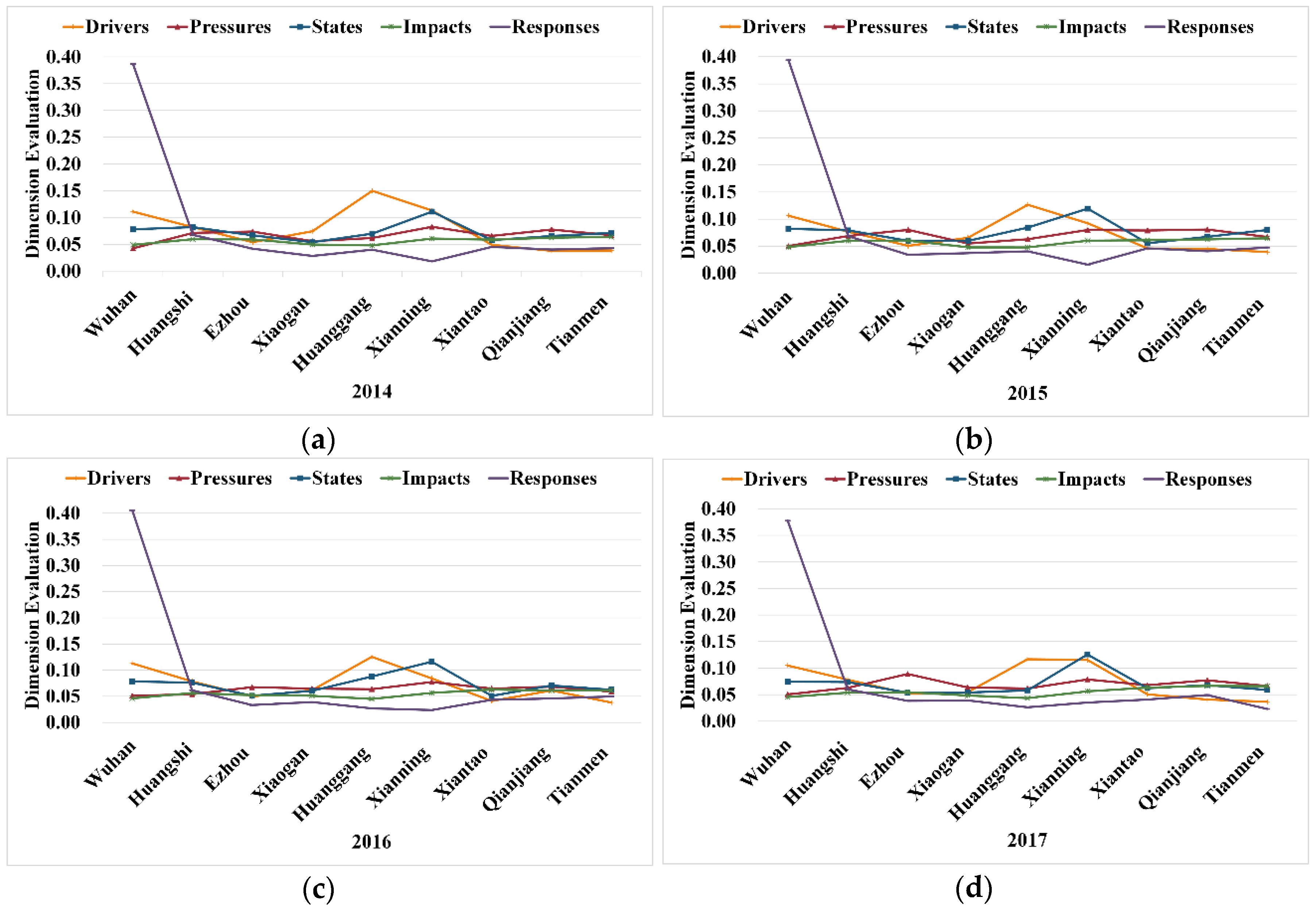
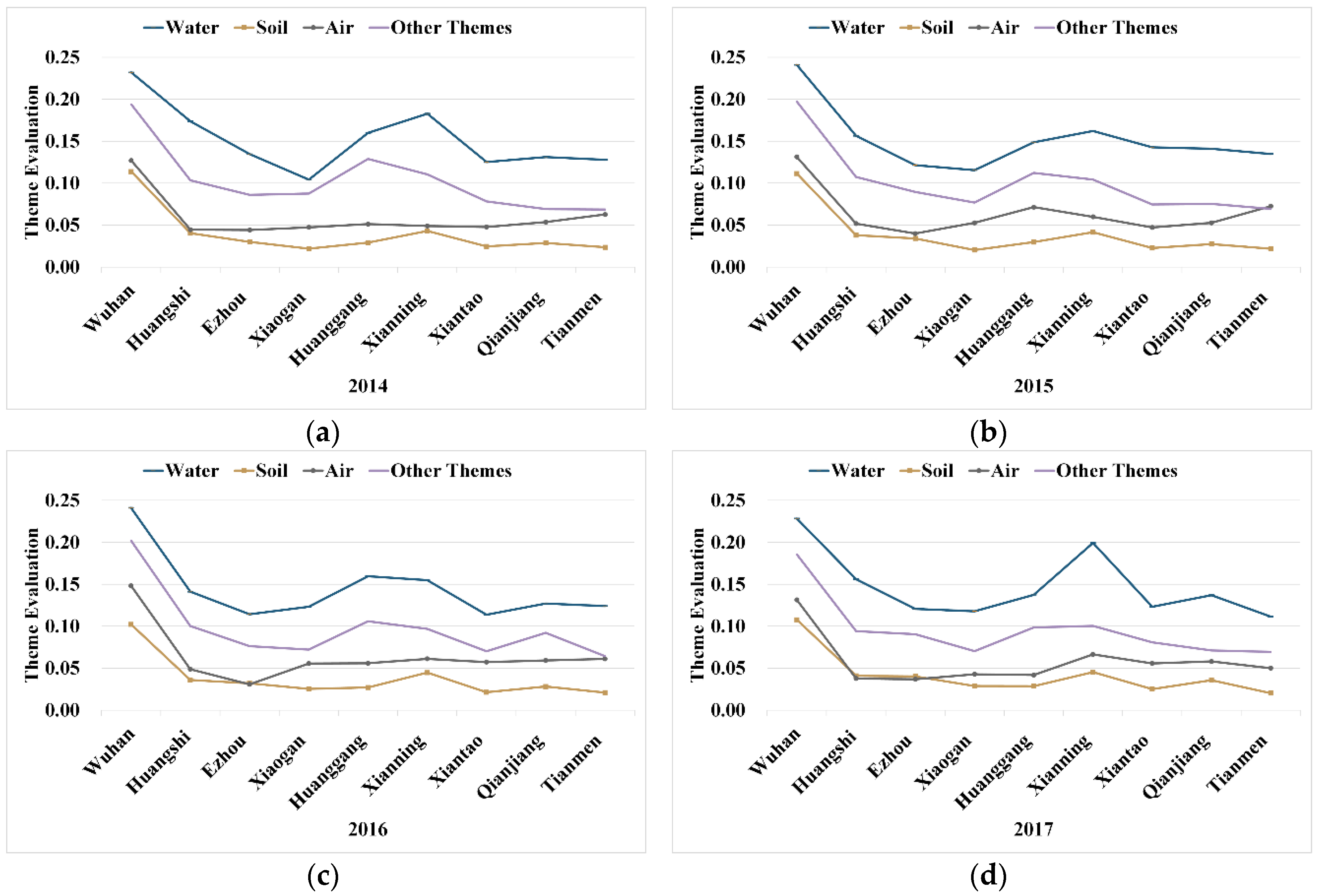
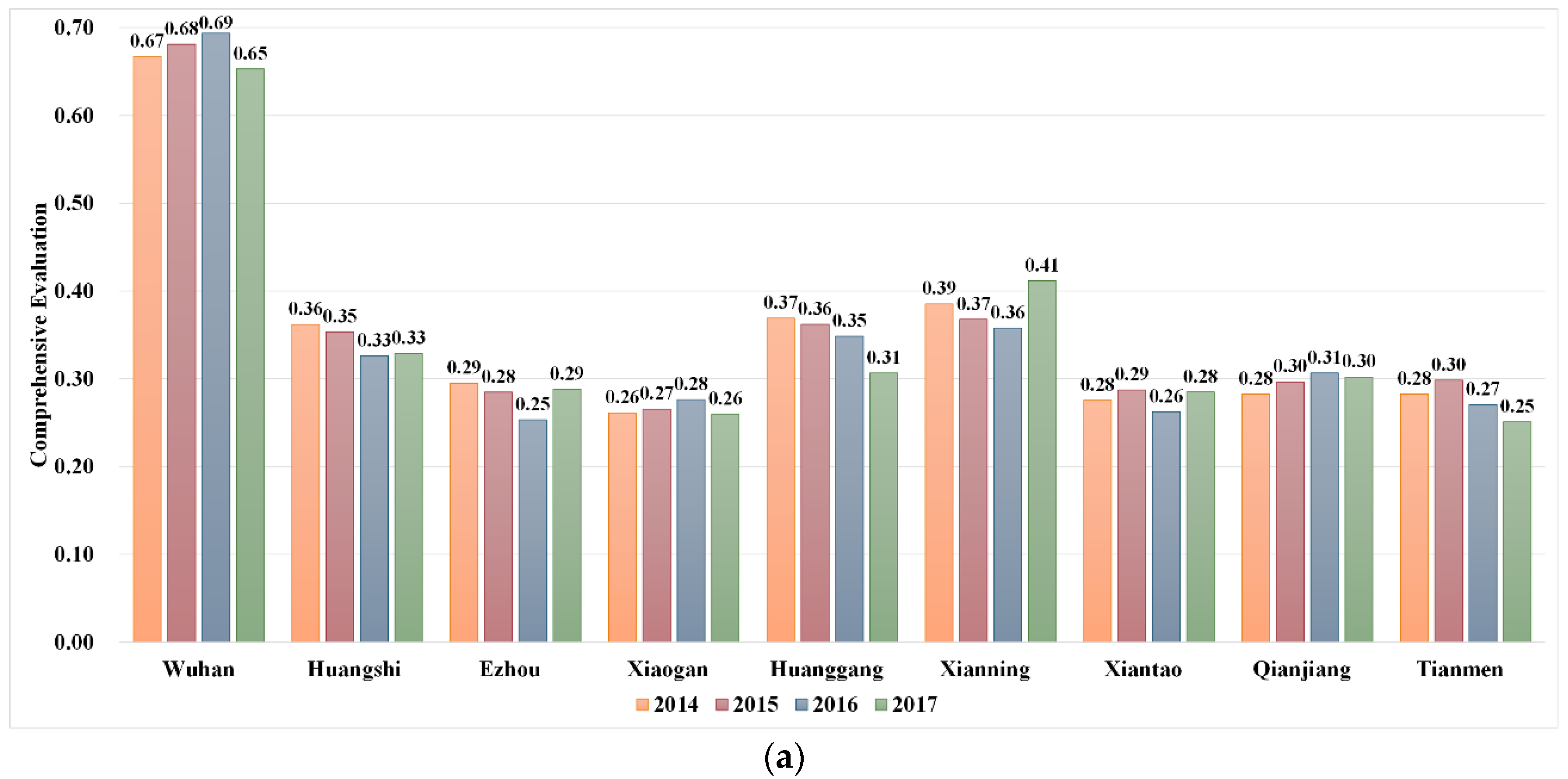
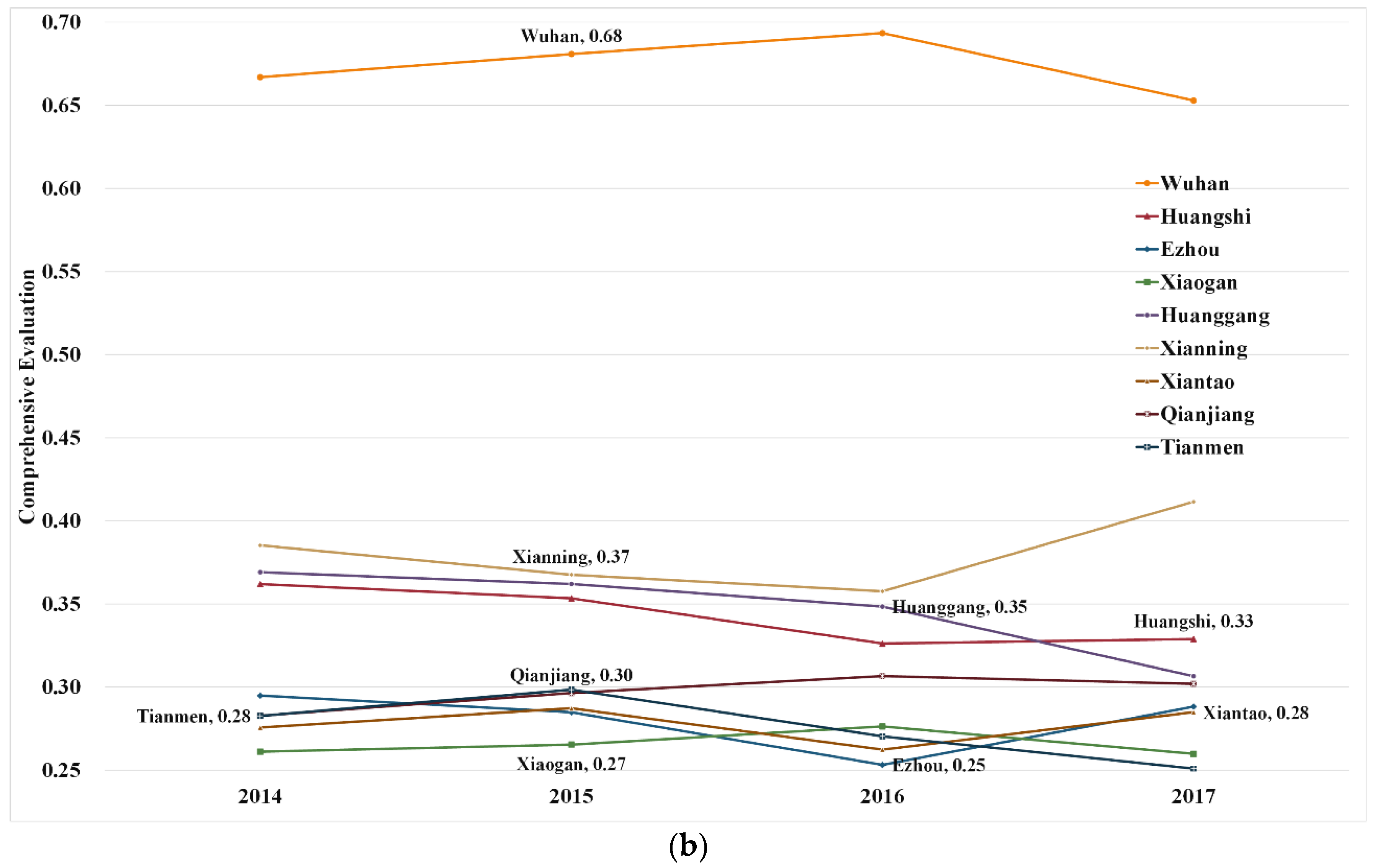
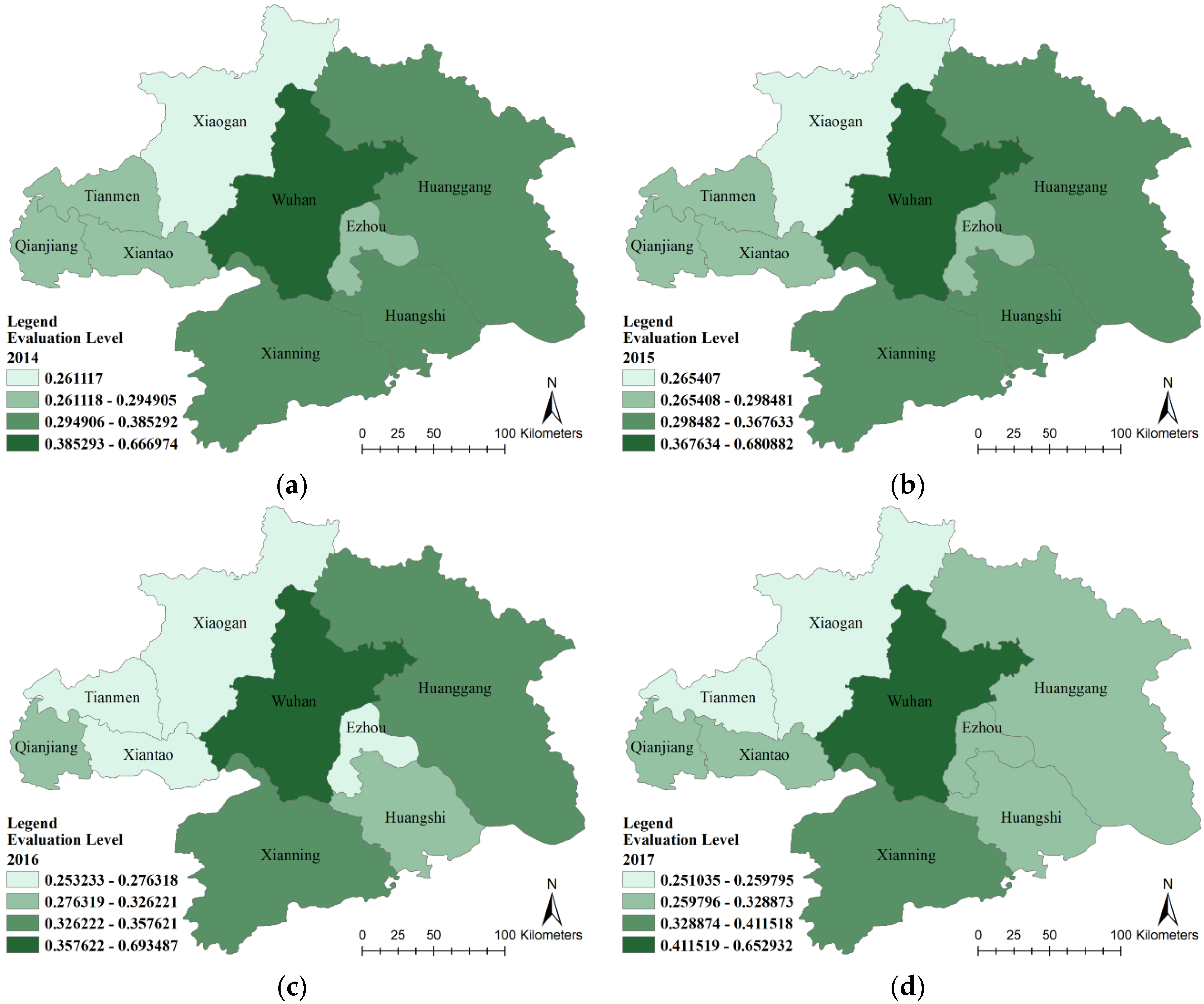
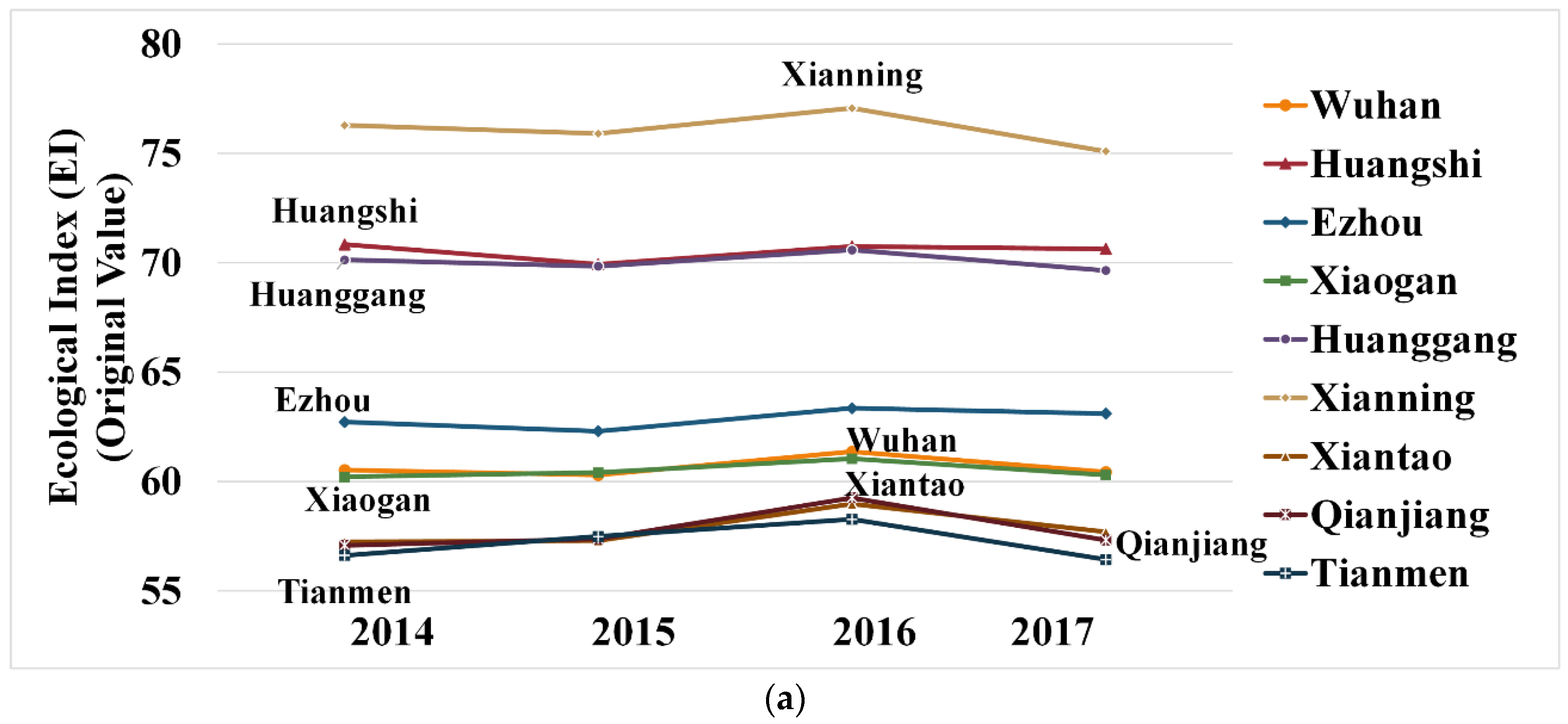
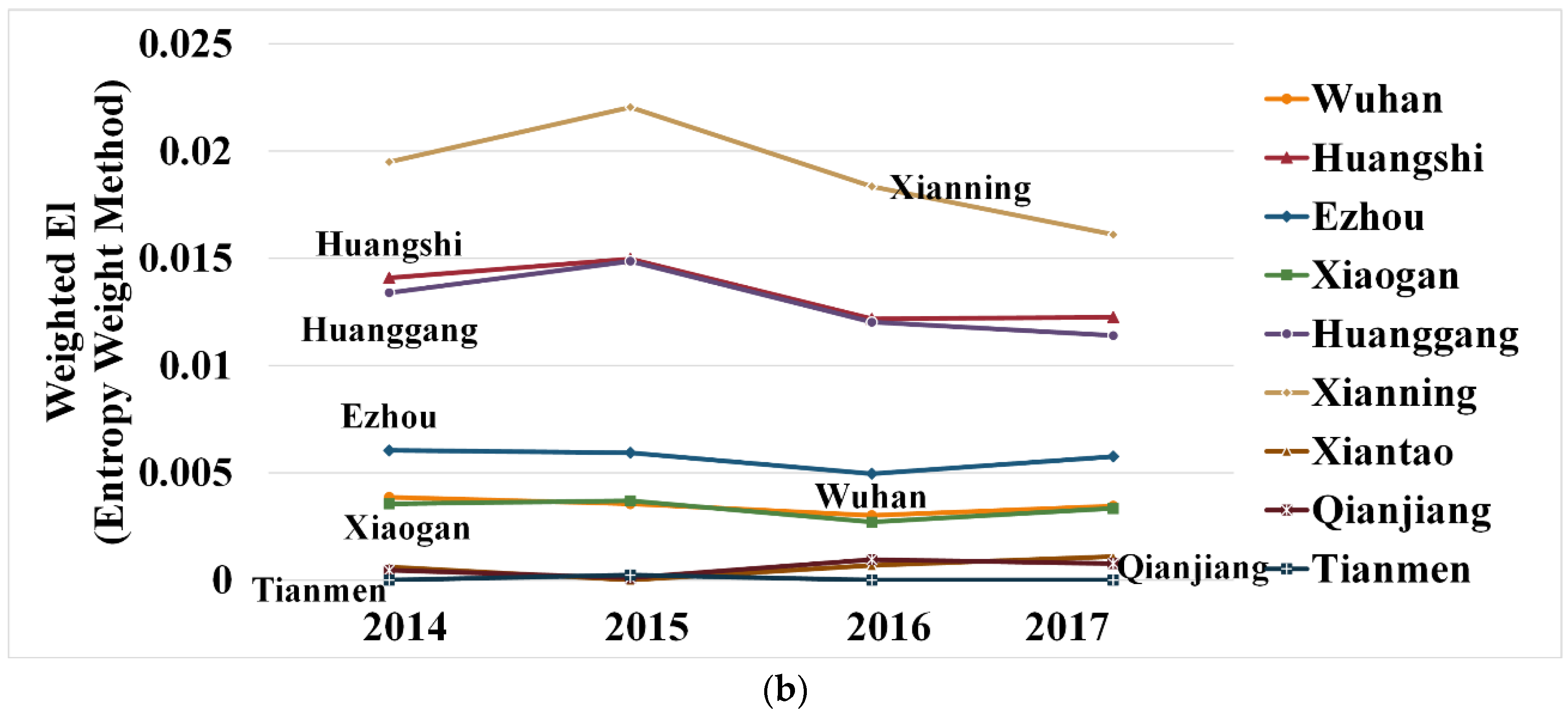
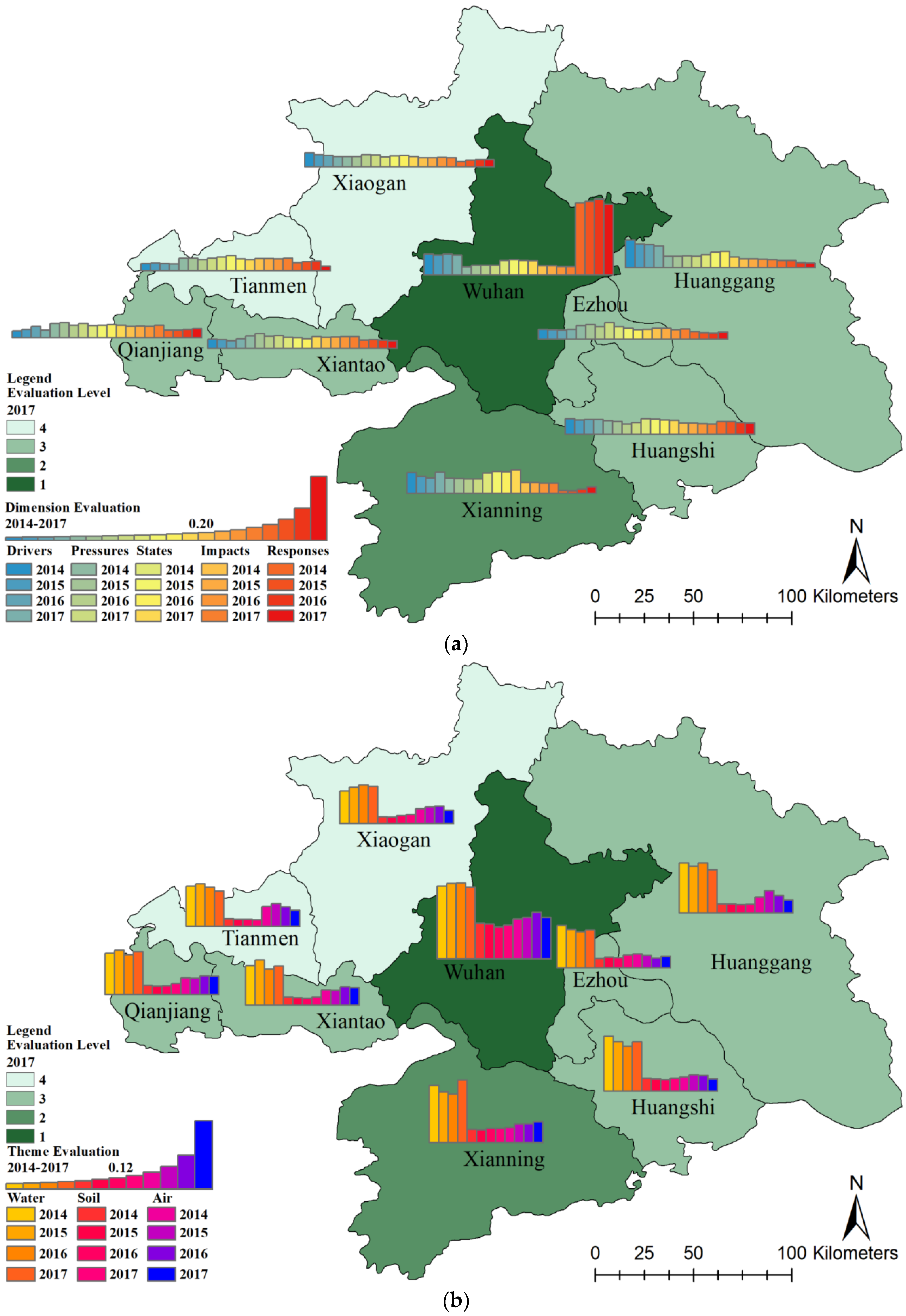
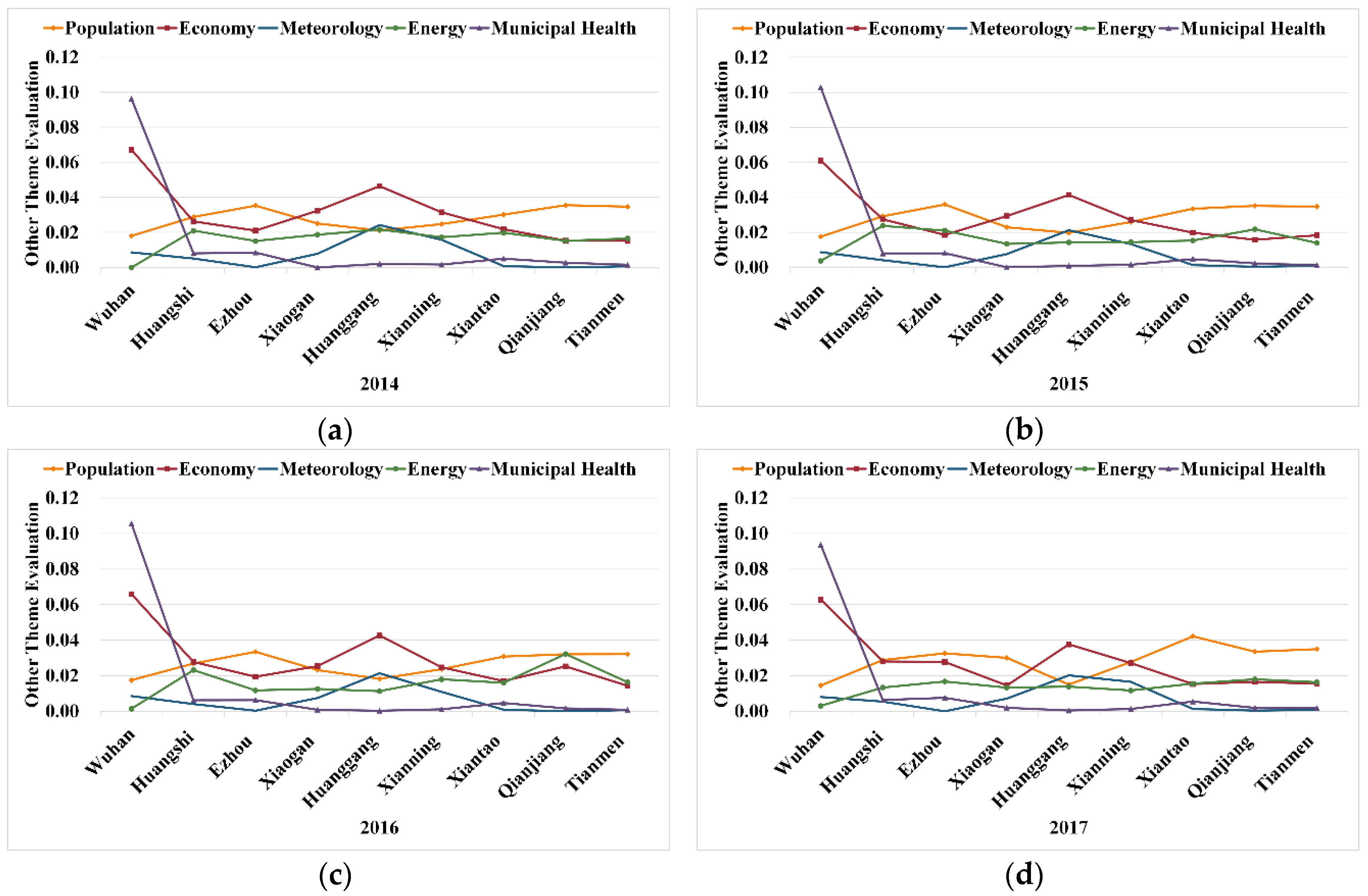
| Indicator System | Standards | |||||
|---|---|---|---|---|---|---|
| ISO 37120:2014 | ISO 37120:2018 | ITU-T Y.4901/L.1601 | ITU-T Y.4902/L.1602 | ITU-T Y.4903/L.1603 | GB/T 33356-2016 | |
| Classification | Core/Supporting | Core/Supporting | Core/Additional | Core/Additional | Core/Additional | × |
| Type Level | √ | √ | √ | √ | √ | √ |
| Dimension | Economy, education, energy, environment, finance, fire and emergency response, governance, health, recreation, safety, shelter, solid waste, telecommunication and innovation, transportation, urban planning, wastewater, water and sanitation | Economy, education, energy, environment and climate change, finance, governance, health, housing, population and social conditions, recreation, safety, solid waste, sport and culture, telecommunication, transportation, urban/local agriculture and food security, urban planning, wastewater, water | Information and communication technology, environmental sustainability, productivity, quality of life, equity and social inclusion, physical infrastructure | Economy, environment, society and culture | Benefit the people service, accurate governance, ecological livable, intelligent facilities, information resources, network security, reform and innovation, citizen experience | |
| Environment | √ | √ | √ | √ | √ | √ |
| Water | ○ | ○ | ○ | ○ | ○ | ○ |
| Soil | ○ | ○ | × | ○ | ○ | ○ |
| Air | ○ | ○ | ○ | ○ | ○ | ○ |
| Definition | √ | √ | √ | √ | √ | ○ |
| Calculation | √ | √ | × | × | ○ | ○ |
| Data Source | ○ | ○ | × | × | ○ | ○ |
| Weight | × | × | × | × | × | √ |
| Integrated Perception Ecological Environment Indicator (IPEEI) Model | ||||
|---|---|---|---|---|
| Dimension | Ecological Environment | Other Themes | ||
| Water | Soil | Air | Population, Economy, Meteorology, Energy, Municipal Health | |
| Drivers | Surface water resources (D10), groundwater resources (D11), water production modulus (D12) | Area of urban construction land (D13) | / | Population of permanent residents at year end (D1), natural population growth rate (D2), urbanization rate(D3), per capita disposable income of urban and rural residents (D4), per capita regional Gross Domestic Product (GDP) (D5), secondary industry as percentage to GDP (D6), tertiary industry as percentage to GDP (D7), regional GDP growth rate (D8), growth rate of industrial added value (comparable price) (D9), annual precipitation (D14), energy consumption per unit of GDP decline (D15) |
| Pressures | Water consumption per capita (P5), water consumption per Mu of farmland irrigation (P6), water consumption per ten thousand yuan of GDP (including primary industry) (P7), water consumption per ten thousand yuan of industrial added value (P8), total water consumption (P9), annual quantity of wastewater discharged (P10) | Industrial land area (P11), road surface area per capita (P12), public recreational green space per capita (P13) | Quantity sold of gas (P14), quantity sold of liquefied petroleum gas (LPG) (P15) | Urban population density (P1), population with access to water supply (P2), population with access to gas (P3), population with access to LPG (P4), annual electricity consumption (P16) |
| States | Ecological Index (EI) (S1) | / | ||
| Average per capita total water resources (S2), average per Mu total water resources (S3), surface water supply quantity (S4), groundwater supply quantity (S5), water supply loss (S6), per capita water consumption of urban residents (S7), urban residential sewage discharge (S8), secondary industry sewage discharge (S9), tertiary industry sewage discharge (S10), sewage discharge into the river (S11) | Green area of built district (S12), green space rate of built district (S13) | Annual average concentration of SO2 (S14), annual average concentration of NO2 (S15), annual average concentration of PM10 (S16) | ||
| Impacts | Daily water consumption per capita (I1), industrial water consumption (I2), agricultural water consumption (I3), domestic water consumption (I4), urban water supply quantity (including self-built facilities) (I5), quantity of water for production and operation (I6), quantity of water for household use (I7) | Green coverage area of built district (I8) | Excellence rate of air quality (I9), household gas quantity (I10), gas-powered automobiles gas quantity (I11), household fuel quantity (I12) | Industrial electricity consumption (I13), electricity consumption of urban and rural residents (I14) |
| Responses | Ecological water use rate (R1), water coverage rate (R2), integrated production capacity of water supply (R3), density of water supply pipelines in built district (R4), density of sewers in built district (R5), wastewater treatment rate (R6), wastewater treated quantity (R7) | Green coverage rate of built district (R8) | Gas coverage rate (R9), ratio of common industrial solid wastes comprehensively utilized (R10), domestic waste collected and transported amount (R11), harmless treatment capacity of domestic waste (R12) | Number of latrines (R13), annual construction funds of municipal public facilities (R14) |
| D1 | D2 | D3 | D4 | D5 | D6 | D7 | D8 | D9 | D10 | D11 | D12 | D13 | D14 | D15 | P1 | P2 | P3 | P4 | P5 | P6 | P7 | P8 | P9 | P10 | |
| 2014 | 0.57 | 0.63 | 1.11 | 1.70 | 1.45 | 1.66 | 2.37 | 0.46 | 0.53 | 2.54 | 2.28 | 1.45 | 0.45 | 2.42 | 1.05 | 0.77 | 0.45 | 0.45 | 0.47 | 0.57 | 0.70 | 0.86 | 0.60 | 0.87 | 0.45 |
| 2015 | 0.55 | 0.46 | 1.05 | 1.64 | 1.43 | 1.10 | 1.97 | 0.54 | 0.57 | 2.38 | 2.21 | 0.80 | 0.44 | 2.12 | 1.30 | 0.96 | 0.44 | 0.44 | 0.47 | 0.53 | 0.96 | 1.44 | 0.78 | 0.91 | 0.44 |
| 2016 | 0.52 | 0.48 | 1.16 | 1.59 | 1.37 | 1.37 | 3.04 | 0.58 | 0.50 | 2.04 | 2.25 | 1.03 | 0.42 | 2.14 | 1.95 | 0.80 | 0.42 | 0.42 | 0.44 | 0.52 | 1.33 | 1.30 | 0.69 | 0.44 | 0.42 |
| 2017 | 0.53 | 1.25 | 0.95 | 1.44 | 1.40 | 0.95 | 2.51 | 0.71 | 0.55 | 2.54 | 2.15 | 1.75 | 0.42 | 2.02 | 0.53 | 1.03 | 0.42 | 0.42 | 0.43 | 0.61 | 1.47 | 1.00 | 0.63 | 0.74 | 0.42 |
| P11 | P12 | P13 | P14 | P15 | P16 | S1 | S2 | S3 | S4 | S5 | S6 | S7 | S8 | S9 | S10 | S11 | S12 | S13 | S14 | S15 | S16 | I1 | I2 | I3 | |
| 2014 | 0.45 | 0.73 | 1.59 | 0.45 | 0.45 | 0.46 | 1.95 | 2.06 | 1.67 | 0.66 | 0.46 | 0.45 | 1.01 | 0.48 | 1.22 | 0.46 | 0.51 | 4.45 | 0.61 | 0.64 | 0.79 | 1.09 | 0.57 | 0.62 | 0.71 |
| 2015 | 0.45 | 0.56 | 1.66 | 0.45 | 0.45 | 0.46 | 2.20 | 1.39 | 1.58 | 0.69 | 0.45 | 0.44 | 1.11 | 0.48 | 1.07 | 0.50 | 0.53 | 4.38 | 0.59 | 1.85 | 0.51 | 0.99 | 0.62 | 0.63 | 0.73 |
| 2016 | 0.43 | 0.55 | 1.55 | 0.42 | 0.43 | 0.43 | 1.84 | 1.10 | 1.75 | 0.61 | 0.42 | 0.42 | 0.86 | 0.92 | 0.79 | 0.45 | 0.49 | 4.09 | 0.52 | 1.07 | 0.61 | 1.04 | 0.61 | 0.61 | 0.53 |
| 2017 | 0.42 | 1.01 | 1.87 | 0.43 | 0.43 | 0.44 | 1.61 | 1.94 | 2.06 | 0.66 | 0.43 | 0.42 | 0.93 | 0.46 | 0.91 | 0.47 | 0.50 | 4.19 | 0.59 | 0.76 | 0.61 | 1.90 | 0.64 | 0.56 | 0.62 |
| I4 | I5 | I6 | I7 | I8 | I9 | I10 | I11 | I12 | I13 | I14 | R1 | R2 | R3 | R4 | R5 | R6 | R7 | R8 | R9 | R10 | R11 | R12 | R13 | R14 | |
| 2014 | 0.57 | 0.45 | 0.45 | 0.45 | 4.53 | 0.48 | 0.45 | 0.45 | 0.47 | 0.48 | 0.46 | 2.79 | 0.45 | 5.17 | 0.99 | 0.76 | 1.21 | 5.55 | 0.72 | 0.55 | 0.72 | 5.52 | 5.31 | 3.27 | 6.36 |
| 2015 | 0.58 | 0.44 | 0.44 | 0.44 | 4.46 | 0.52 | 0.44 | 0.44 | 0.46 | 0.47 | 0.47 | 2.29 | 0.44 | 5.46 | 1.08 | 0.78 | 1.06 | 5.61 | 0.74 | 0.83 | 0.58 | 6.08 | 4.86 | 3.63 | 6.65 |
| 2016 | 0.54 | 0.42 | 0.42 | 0.42 | 4.20 | 0.94 | 0.42 | 0.42 | 0.44 | 0.45 | 0.44 | 1.66 | 0.42 | 5.43 | 1.29 | 0.75 | 0.84 | 5.27 | 0.70 | 0.76 | 0.76 | 6.36 | 6.30 | 3.53 | 7.03 |
| 2017 | 0.59 | 0.42 | 0.42 | 0.42 | 4.17 | 1.03 | 0.42 | 0.43 | 0.44 | 0.46 | 0.44 | 2.52 | 0.42 | 5.24 | 0.75 | 1.07 | 0.63 | 5.49 | 0.94 | 0.43 | 0.53 | 6.21 | 5.39 | 2.91 | 6.46 |
| Indicator | EI ≥ 75 | 55 ≤ EI<75 | 35 ≤ EI < 55 | 20 ≤ EI < 35 | EI < 20 |
|---|---|---|---|---|---|
| Description | High vegetation coverage, rich biodiversity, and stable ecosystem | Relatively high vegetation coverage, relatively rich biodiversity, and suitable for life | Medium vegetation coverage, average biodiversity, more suitable for human life, and some restrictive factors that are not suitable for human life | Poor vegetation coverage, severe drought and less rainfall, fewer species, and obvious factors that restrict human life | Bad conditions, and restricted human life |
| Classification Code of the Indicator in the IPEEI Model | |
|---|---|
| Positive Indicator | D3, D4, D5, D7, D8, D9, D10, D11, D12, D14, D15 P13 S1, S2, S3, S12, S13 I8, I9 R1, R2, R3, R4, R5, R6, R7, R8, R9, R10, R11, R12, R13, R14 |
| Negative Indicator | D1, D2, D6, D13 P1, P2, P3, P4, P5, P6, P7, P8, P9, P10, P11, P12, P14, P15, P16 S4, S5, S6, S7, S8, S9, S10, S11, S14, S15, S16 I1, I2, I3, I4, I5, I6, I7, I10, I11, I12, I13, I14 |
© 2020 by the authors. Licensee MDPI, Basel, Switzerland. This article is an open access article distributed under the terms and conditions of the Creative Commons Attribution (CC BY) license (http://creativecommons.org/licenses/by/4.0/).
Share and Cite
Liu, Y.; Du, W.; Chen, N.; Wang, X. Construction and Evaluation of the Integrated Perception Ecological Environment Indicator (IPEEI) Based on the DPSIR Framework for Smart Sustainable Cities. Sustainability 2020, 12, 7112. https://doi.org/10.3390/su12177112
Liu Y, Du W, Chen N, Wang X. Construction and Evaluation of the Integrated Perception Ecological Environment Indicator (IPEEI) Based on the DPSIR Framework for Smart Sustainable Cities. Sustainability. 2020; 12(17):7112. https://doi.org/10.3390/su12177112
Chicago/Turabian StyleLiu, Yingbing, Wenying Du, Nengcheng Chen, and Xiaolei Wang. 2020. "Construction and Evaluation of the Integrated Perception Ecological Environment Indicator (IPEEI) Based on the DPSIR Framework for Smart Sustainable Cities" Sustainability 12, no. 17: 7112. https://doi.org/10.3390/su12177112
APA StyleLiu, Y., Du, W., Chen, N., & Wang, X. (2020). Construction and Evaluation of the Integrated Perception Ecological Environment Indicator (IPEEI) Based on the DPSIR Framework for Smart Sustainable Cities. Sustainability, 12(17), 7112. https://doi.org/10.3390/su12177112








